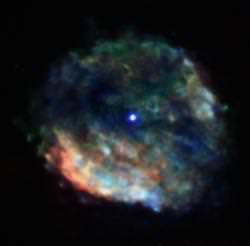When a star with at least 8 times the mass of our Sun detonates as a supernova, it leaves behind a neutron star. This tiny object has the mass of a star, but it’s compressed down to a ball only 10 km (6 miles) across – its protons and electrons have been compressed together to form neutrons. One of these objects has puzzled astronomers for years, but now researchers think they’ve found the solution: it’s got a friend.
New data gathered by NASA’s Chandra X-Ray Observatory is helping to explain the mystery in RCW 103. This supernova remnant, located 10,000 light-years away, detonated about 2,000 years ago (I know, that means it really exploded 12,000 years ago). The bright blue dot at the centre of the image is the neutron star, blasting out X-ray radiation.
The problem with this neutron star is that only rotates once every 6.7 hours. That sounds fast, but there are neutron stars out there that can rotate many times a second. It should be turning much faster.
One possible answer for the mystery is that the original star that detonated, leaving this remnant wasn’t alone. It might have had a much lower-mass companion which still remains. It was the magnetic field interaction between the neutron star and the low-mass companion slowed down its rotation.
Original Source:Chandra

